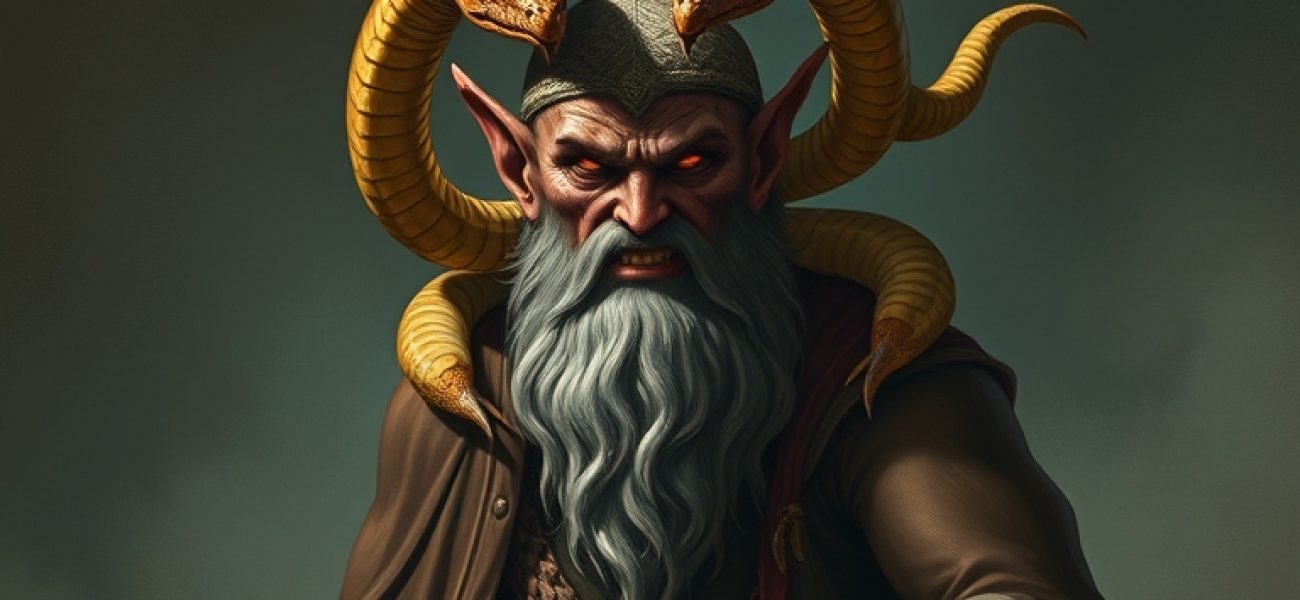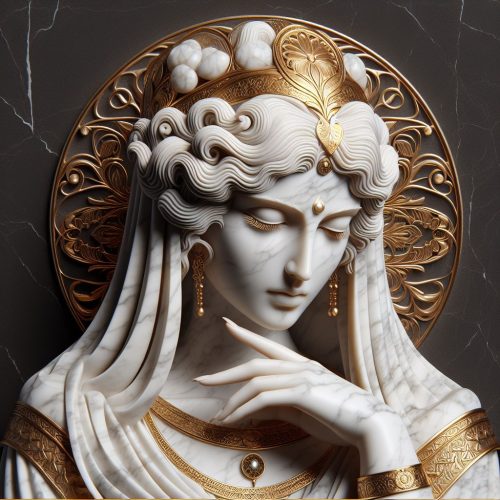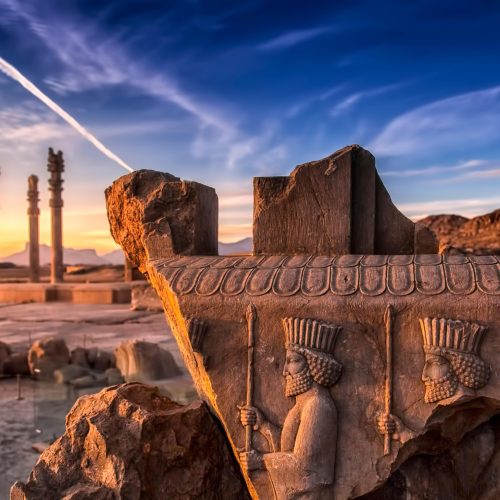By Dr. Farhad Mirza-Hosseini Iranian Studies Department, University of Tehran
In the vast tapestry of Iranian mythology, few figures loom as large or cast as dark a shadow as Zahhak (Aži Dahāka). This thousand-year-old tale, preserved in both Zoroastrian religious texts and Ferdowsi’s masterwork Shahnameh, presents us with a complex figure who embodies the eternal struggle between good and evil, order and chaos, light and darkness. Through careful examination of these ancient sources, we can trace how this mythological figure evolved from the three-headed dragon Aži Dahāka of the Avesta to become Zahhak, the tyrannical Arab king whose thousand-year reign brought darkness to ancient Iran.
Origins in Zoroastrian Literature
The earliest mentions of our serpentine antagonist appear in the Avesta, where he is known as Aži Dahāka. The prefix “Aži” specifically denotes a dragon or serpent, while “Dahāka” may be related to the ancient Iranian root meaning “burning” or “stinging.” In these ancient texts, he appears as a three-headed, six-eyed dragon, created by the evil spirit Angra Mainyu to destroy the good creation of Ahura Mazda.
The Younger Avesta presents Aži Dahāka as offering a sacrifice to the goddess Anahita, seeking the power to make all seven regions of the earth devoid of humans. This early characterization emphasizes his role as an agent of chaos and destruction, aligned with the forces that seek to undo the divine order of creation. The Denkard, a 9th-century compilation of Zoroastrian beliefs, further elaborates on his nature as a manifestation of evil, describing him as possessed by countless demons (daevas) that strengthen his destructive powers.
In these religious texts, Aži Dahāka represents more than just a mythological monster; he embodies the cosmic principle of evil itself. His eventual binding (rather than death) at Mount Damavand symbolizes how evil can be contained but never fully destroyed until the final battle at the end of time. This theological understanding of Aži Dahāka provides the foundation for his later literary development in the Shahnameh.
Transformation in the Shahnameh
When we turn to Ferdowsi’s Shahnameh, composed in the late 10th century CE, we find the dragon transformed into a more human figure, though no less terrifying. Ferdowsi’s Zahhak is an Arab prince who, through a Faustian pact with Ahriman (the Persian devil), gains the throne of Iran. The story of his rise to power serves as a masterful psychological study of corruption and the gradual destruction of human conscience.
In Ferdowsi’s telling, Zahhak begins as Zahak, son of an Arabian ruler named Merdas. The young prince is described as brave but naive, making him perfect prey for Ahriman’s manipulations. The evil spirit first appears to him as a well-wishing counselor, gradually poisoning his mind against his father. After convincing Zahhak to murder his own father, Ahriman appears in another guise as a skilled cook, preparing exotic dishes that entrance the young king. This seemingly innocent act of culinary seduction leads to the most infamous aspect of Zahhak’s transformation – the sprouting of two black snakes from his shoulders.
The image of the snakes growing from Zahhak’s shoulders represents a masterful literary evolution of the three-headed dragon from the Avesta. These serpents, which must be fed human brains daily, serve as both a physical manifestation of his evil nature and a metaphor for the insatiable appetites of tyranny. Each day, two young men must be sacrificed to feed these snakes, creating a reign of terror that lasts for a thousand years.
The Symbolism of Suffering
The story of Zahhak carries deep symbolism about the nature of evil and tyranny. His thousand-year reign represents a dark age in Iranian mythology, a period when the forces of chaos gain ascendancy over order. The daily feeding of human brains to his shoulder-snakes presents a powerful image of how tyranny sustains itself through the systematic destruction of youth and wisdom.
Perhaps most interesting is how Ferdowsi portrays the psychological deterioration of Zahhak. Despite his monstrous transformation, he remains terrifyingly human. He is plagued by nightmares of his eventual defeat at the hands of Feraydun, a righteous prince who will rise against him. These dreams reveal the tyrant’s inner torment and fear, suggesting that even the most corrupted ruler cannot entirely escape the consciousness of their own evil.
The character of Zahhak’s vizier, Karshah, adds another layer to this exploration of evil. When faced with the daily task of selecting victims for the snakes, Karshah devises a plan to save half of the intended victims by mixing animal brains with human ones. This act of resistance within the heart of evil itself suggests that even in the darkest times, the human capacity for compassion cannot be entirely extinguished.
The Role of Prophecy and Destiny
One of the most compelling aspects of the Zahhak narrative is its treatment of prophecy and destiny. In both the Zoroastrian texts and the Shahnameh, Zahhak’s eventual defeat is foretold, yet he remains powerless to prevent it. This creates a fascinating tension between free will and destiny that runs throughout the tale.
The prophecy of Feraydun, the hero destined to overthrow Zahhak, haunts the tyrant’s dreams. Despite all his power and the armies at his command, Zahhak cannot escape his ordained fate. This aspect of the story reflects a deeply Iranian worldview about the ultimate triumph of good over evil, while simultaneously acknowledging the terrible cost of that victory.
The Revolution of Kaveh
No discussion of the Zahhak myth would be complete without examining the pivotal role of Kaveh the Blacksmith. After losing eighteen of his sons to Zahhak’s serpents, Kaveh becomes the catalyst for revolution. His simple leather apron, raised as a banner of rebellion, becomes the legendary Derafsh Kaviani, the standard of Iranian independence and resistance against tyranny throughout history.
The story of Kaveh introduces a crucial popular element to the narrative. While Feraydun represents divine destiny and royal legitimacy, Kaveh represents the power of popular uprising against injustice. His rebellion transforms the story from a purely mythological tale into a powerful political allegory about the right of resistance against tyrannical rule.
The Binding at Damavand
The conclusion of Zahhak’s story is as rich in symbolism as its beginning. Rather than being killed, Zahhak is bound inside Mount Damavand, where he will remain until the end of time. This imprisonment, rather than death, carries significant theological and philosophical implications. In Zoroastrian eschatology, evil cannot be permanently destroyed until the final renovation of the world (Frashkard). Until then, it can only be contained and restricted.
The choice of Mount Damavand as Zahhak’s prison is itself significant. This highest peak in Iran, with its volcanic nature and imposing presence, serves as a perfect symbolic boundary between the worlds of order and chaos. Local folklore maintains that the mountain’s occasional rumblings are caused by Zahhak struggling against his bonds, and that his eventual breaking free will herald the final battle between good and evil.
Literary Legacy and Contemporary Relevance
The enduring power of the Zahhak myth lies in its adaptability to different historical contexts while maintaining its core message about the nature of evil and the necessity of resistance. Throughout Iranian history, various tyrannical rulers have been compared to Zahhak, while popular uprisings have drawn inspiration from Kaveh’s rebellion.
Modern Iranian writers and artists continue to find new meanings in this ancient tale. The story has been reinterpreted through various contemporary lenses – political, psychological, and social. Some see in Zahhak’s shoulder-snakes a metaphor for addiction to power, while others interpret the daily feeding of young men’s brains as representing the destruction of a nation’s intellectual capital by repressive regimes.
The Eternal Relevance of Myth
The story of Zahhak, in both its Zoroastrian and Shahnameh variations, represents more than just an ancient tale of good versus evil. It offers a sophisticated exploration of how evil takes root in the human heart, how it maintains its power, and ultimately, how it can be resisted and overcome.
The transformation of the character from the purely mythological dragon Aži Dahāka to the more human Zahhak reflects the Iranian literary genius for combining theological depth with psychological insight. In Ferdowsi’s hands, the story becomes a mirror in which we can examine the nature of tyranny itself – its origins, its methods of maintaining power, and its inevitable confrontation with the forces of justice and freedom.
As we continue to grapple with questions of power, corruption, and resistance in our own time, the story of Zahhak remains remarkably relevant. It reminds us that the struggle against tyranny and injustice is not just a political or social phenomenon, but part of an eternal cosmic battle between the forces of creation and destruction, order and chaos, good and evil.
The binding of Zahhak at Mount Damavand serves as both warning and promise – warning that evil, though contained, remains a constant threat, and promise that through courage, wisdom, and unity, even the most terrible tyranny can be overcome. In this way, the ancient myth continues to speak to modern audiences, offering both caution and hope in our own struggles against the forces of darkness and oppression.
About the Author: Dr. Farhad Mirza-Hosseini is a Professor of Iranian Studies specializing in ancient Iranian mythology and literature. His work focuses on the intersection of mythology, religion, and political thought in classical Persian literature. He has published extensively on the Shahnameh and its contemporary relevance.




